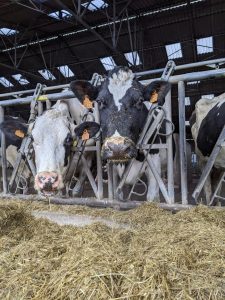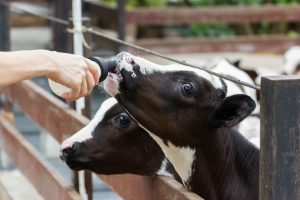Álvaro García
On most dairy farms, calves are separated from their dams within hours of birth. This has been standard practice for decades, often for good reason, managing colostrum, tracking milk yield, and keeping calves safe and healthy in controlled settings. But times are changing. Consumers are asking more questions about how food is produced. Animal well-being has become part of how milk is perceived, and many people see early cow-calf separation as unnatural or unnecessary.
In response, a small but growing number of producers in Europe and elsewhere are testing out systems where cows and calves stay together for days, weeks, or even months. These farms are exploring different ways to make the system work, from full-time contact to part-time access, from dam rearing to foster cow models. They’re marketing their milk under specialty labels, charging premiums, and reporting new kinds of satisfaction from seeing their animals behave more naturally.
Cow-calf contact to market ethical milk and win consumer trust
In Germany, the label “Kuhgebundene Kälberaufzucht” translates to mother-bonded calf rearing and is used to indicate that calves remain with their mothers for an extended period. In Austria and Switzerland, farms use the label “Kalb-bei-der-Kuh”, meaning calf with the cow, to emphasize natural mother-young bonding and improved welfare. Meanwhile, in the Netherlands, the phrase “Zorg voor koe en kalf”, or care for cow and calf, appears on products from farms where cow-calf contact is prioritized as part of a broader animal-friendly approach. These labels appeal to consumers seeking ethically produced dairy and often command premium prices.
Some small-scale or organic dairies market milk from cow-calf systems as more ethical or natural and charge a premium. These operations often label their milk with phrases like: “Calf-at-foot milk”, “Mothered milk”, “Ethical dairy”, and “Cow and calf stay together”. “The Ethical Dairy” of Scotland is one example that charges a significantly higher price for milk produced under these conditions, using cow-calf contact as a key marketing point. This shift responds to growing consumer demand for transparency, where animal welfare is now a marketing tool as much as a production practice.
Still, this isn’t a simple shift. Farmers need answers. How does it affect mastitis risk? Does the calf still drink colostrum effectively? Will calves be harder to handle? How do you wean without causing stress? And perhaps most important, how does this fit into the real-life demands of running a modern dairy?
In this article we explore what research says, but also ask what it means for people who are actually milking cows, feeding calves, and trying to make a living.
Lessons from farmers and researchers
While the farms, climates, and breeds in northern European countries differ, many share the same concerns: how to manage the cows, what the calves need, how much extra work is involved, and whether the system is sustainable, both financially and emotionally. At recent European farmer meetings, participants agreed we are still in the early stages of understanding what makes these systems succeed or fail. One of the biggest challenges is that there’s no one right way to do it, no one-fits-all scheme. Some farms give calves 24-hour access to their dam, while others only allow contact after milking. Some use foster cows, where a few cows nurse multiple calves. Others pull the calf after a few days and feed them harvested milk. These setups are so different that it is hard to compare them directly or apply results from one farm to another.
Another issue is the controls used in studies. Many of the early papers looked at beef cows or cattle raised on pasture, which don’t reflect the demands of modern dairy cows bred for high milk output. More recent studies compare cow-calf systems with traditional dairy setups, but that brings up other problems. For example, a calf raised with a cow might drink 12–15 liters of milk a day, while a bottle-fed calf might only get 6 or 8. Naturally, the calf raised with the dam will grow faster, but is that due to maternal contact, or simply greater milk intake? We also know from controlled studies that calves fed high-protein milk replacers (22% protein) grow larger and more efficiently than those receiving lower-protein formulations (18%), even under similar feeding volumes. This raises the question of how much of the benefit seen in cow-calf systems is due to nutrition alone versus the behavioral and physiological effects of mother-young contact (Garcia. 2023a.).
Space is another confounding factor. Farms that keep cows and calves together often offer larger pens or more outdoor access. That alone could explain why these calves play more or seem calmer, not just the maternal bond. So when studies report behavioral benefits, we need to ask: is it the dam, the milk, the space, or some combination thereof? From a farmer’s point of view, what matters is not just the science, it is whether the system can work in the real world, with his herd, barn, and workload. That’s why more on-farm trials, not just university studies, are needed to build a clearer picture.
What happens when you let cows raise their calves?
Yes, the farm will produce less saleable milk—at least in the short term. When a calf is nursing, it is drinking milk that would otherwise go into the tank. How much depends on the system. In full-contact setups, calves can easily drink 10 to 15 liters a day. Some producers manage this by separating cow and calf after each milking, while others use part-time access (like daytime-only nursing), or switch to foster cows to limit losses from high-producing animals.
However, producers who have used these systems long term say the loss may not be as large as it looks on paper. That’s because cows often produce more milk when they’re nursing—the hormonal stimulation from the calf aids in milk letdown and may boost total output. One study found that the reduction in tank milk was not as steep as expected, as the cow’s overall production increased slightly. Of course, this depends heavily on breed, feeding level, and how milking is managed. In addition to potential gains in milk production, some producers report a reduction in mastitis cases when calves are allowed to nurse. The mechanical action of suckling may help empty quarters more completely and more frequently than machine milking alone. While scientific research on this is limited, a few observational studies and on-farm trials suggest that nursing calves can help reduce the risk of intramammary infections, particularly in early lactation. As discussed by Meagher et al. (2024), calf suckling may reduce early lactation mastitis by promoting complete and frequent milk removal, although results vary depending on management. However, the effect varies, and some researchers caution that udder health also depends on hygiene, calf management, and how the nursing process is integrated with regular milking routines. Conversely, some farmers worry that missing milkings or irregular drainage from nursing could lead to udder infections. So far, the research is mixed. In well-managed systems, mastitis rates don’t seem to increase—and in some cases, cows that nursed had better udder health than those milked only by machine. Still, poor hygiene or uneven milk removal can create problems.
There’s no question that calves raised with their dams grow fast. They drink more milk, often more frequently, and sometimes nurse until several months of age. Gains of over 1 kg/day are not unusual—well above what’s typically seen in individually penned calves on limited milk. But a big part of that growth is about access to more milk, not just the presence of the mother.
Calves raised with cows often show lower levels of scours and fewer respiratory problems than those housed individually. They have stronger immune systems and seem to bounce back from challenges more quickly. This might be due to better colostrum transfer, more frequent nursing, or just less stress. But when groups are large or calves mix with multiple cows, disease risk can increase.
Weaning, separation, and calf behavior: how to do it without stressing everyone out
Weaning in these systems isn’t just about cutting off milk, it is about breaking a bond between two animals that know each other well. If it is done suddenly or without planning, it can cause stress for both cow and calf. Producers who use these systems often reduce contact gradually, first limiting access to a few hours a day, then separating completely once the calf is eating solid feed. Others move calves to a pen near the cow so they can still see and hear each other for a few days. “Nose flaps” are also used to prevent nursing while keeping the animals together.
Nursing does not stop the calf from eating solids. In fact, studies show that when calves are offered hay and grain along with milk and cow contact, they learn to ruminate early and adapt well to weaning (Garcia 2025b.). What matters is a gradual transition.
Letting calves nurse sounds easier than bottle-feeding, but it can complicate other tasks, like milking, cleaning, and handling. You’ll need pens that allow for safe movement of animals, areas where calves can rest away from adult cows, and routines that let workers monitor both cow and calf health. Labor needs may shift, less time feeding calves, more time observing and adjusting groups.
Farms that have transitioned successfully often build in flexibility, pens that can be opened or closed to adjust contact, areas where calves can escape cow traffic, and setups that make weaning smoother. Workers also need support, since it’s harder to spot illness in a group setting. Good training, clear protocols, and team communication are key.
Does it pay off? Economics and sustainability
At first glance, these systems may look more expensive: less milk sold, more housing space needed, and possibly more labor. But the full picture is more complex. Calves raised on cows grow faster and may be healthier, reducing treatment costs and early losses. Some farms sell milk under welfare-friendly labels, earning premiums. When male calves are raised on-site for beef, more value is captured from each birth. Whether it “pays off” depends on your goals. If you’re aiming for liters in the tank, it’s a harder case to make. But if you’re building a resilient farm with healthy animals, satisfied customers, and a strong story to tell, the value might be there. Keeping cows and calves together isn’t about going back to the past. It’s about finding smarter, more transparent ways to raise healthy animals while meeting social expectations. It challenges us to think beyond efficiency alone and consider long-term sustainability, biological, economic, and social. The system may not work for everyone. But the lessons it offers, about behavior, management, and communication, can help any farm rethink its calf-rearing approach.
Before adopting a cow-calf system, producers might consider the following questions:
- Do I have pens or spaces that allow safe contact while still letting me monitor animals individually?
- Can I afford to lose some saleable milk in exchange for faster calf growth or health?
- Do I have a weaning plan that avoids sudden separation?
- Are my staff trained to observe health signs in more open calf housing?
- Can I track long-term calf outcomes to see if the system pays off?
- Am I in a market where consumers value animal welfare and transparency?
© 2025 Dellait Knowledge Center. All Rights Reserved.









